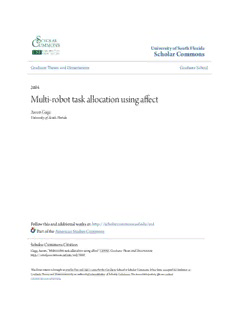Table Of ContentUUnniivveerrssiittyy ooff SSoouutthh FFlloorriiddaa
DDiiggiittaall CCoommmmoonnss @@ UUnniivveerrssiittyy ooff
SSoouutthh FFlloorriiddaa
USF Tampa Graduate Theses and Dissertations USF Graduate Theses and Dissertations
8-18-2004
MMuullttii--RRoobboott TTaasskk AAllllooccaattiioonn UUssiinngg AAffffeecctt
Aaron Gage
University of South Florida
Follow this and additional works at: https://digitalcommons.usf.edu/etd
Part of the American Studies Commons
SScchhoollaarr CCoommmmoonnss CCiittaattiioonn
Gage, Aaron, "Multi-Robot Task Allocation Using Affect" (2004). USF Tampa Graduate Theses and
Dissertations.
https://digitalcommons.usf.edu/etd/1042
This Dissertation is brought to you for free and open access by the USF Graduate Theses and Dissertations at
Digital Commons @ University of South Florida. It has been accepted for inclusion in USF Tampa Graduate Theses
and Dissertations by an authorized administrator of Digital Commons @ University of South Florida. For more
information, please contact [email protected].
Multi-RobotTaskAllocationUsingAffect
by
AaronGage
Adissertationsubmittedinpartialfulfillment
oftherequirementsforthedegreeof
DoctorofPhilosophy
DepartmentofComputerScienceandEngineering
CollegeofEngineering
UniversityofSouthFlorida
MajorProfessor:RobinMurphy,Ph.D.
KimonValavanis,Ph.D.
LarryHall,Ph.D.
RajivDubey,Ph.D.
DateofApproval:
August18,2004
Keywords: robotics,multi-agents,recruitment,emotions
(cid:13)c Copyright2004,AaronGage
Dedication
Thisworkisdedicatedtothefamilyandfriendswhosesupportmadeitpossible.
Acknowledgments
PortionsofthisworkweresupportedbyONRGrantN00014-03-1-0786andDOEGrant
DE-FG02-01ER45904. TheauthorwouldalsoliketothankRobinMurphyforherguidanceandsupport
throughoutthedevelopmentofthisthesis;MiguelLabradorforpointingoutMarkovmodelsforwireless
networklosses;andMattLongformakingtheunderlyingSFXrobotarchitectureworkjustintimefor
simulationsandrealrobottests.
TableofContents
ListofTables iii
ListofFigures v
Abstract vi
ChapterOne Introduction 1
1.1 Multi-RobotTaskAllocation 1
1.2 MotivatingExample 3
1.3 ResearchQuestion 6
1.4 WhyUseAffect? 6
1.5 CommunicationsChallenge 8
1.6 TheNeedforaFitnessFunction 10
1.7 Contributions 10
1.7.1 ArtificialIntelligence 10
1.7.2 Robotics 11
1.7.3 CognitivePsychology 12
1.8 OrganizationofThesis 12
ChapterTwo RelatedWork 14
2.1 Multi-RobotTaskAllocation 15
2.1.1 Motivation-based: ALLIANCE 15
2.1.1.1 OtherMotivation-basedAllocationResearch 20
2.1.2 Auctions: MURDOCH 20
2.1.2.1 OtherAuction-basedApproaches 23
2.1.2.2 UtilityMetrics 24
2.1.3 OtherApproaches 24
2.2 DistributedSensing 26
2.3 EmotionsandAffectiveComputing 30
2.3.1 EmotionsinRobots 30
2.3.2 OCCModelofEmotions 31
2.4 FoundationofApproach 34
2.5 Summary 34
ChapterThree Approach 38
3.1 RobustCommunicationProtocol 38
3.2 FormalDescriptionofAffectiveRecruitment 41
3.3 MultivariateMetricEvaluationFunctions 46
3.4 Summary 48
i
ChapterFour Experiments 51
4.1 ExperimentalDesign 52
4.1.1 Scenario 52
4.1.2 RecruitmentStrategies 54
4.2 ExperimentalSimulations 55
4.2.1 EffectsofTeamSize 55
4.2.1.1 StatisticalAnalysis 55
4.2.1.2 ResultsforNumberofMessagesMetric 57
4.2.1.3 ResultsforAverageWaitTimeMetric 57
4.2.1.4 SummaryofTeamSizeSimulations 62
4.2.2 EffectsofCommunicationLoss 63
4.2.2.1 StatisticalAnalysis 63
4.2.2.2 ResultsforNumberofMessagesMetric 64
4.2.2.3 ResultsforAverageWaitTimeMetric 64
4.2.2.4 SummaryofCommunicationLossSimulations 64
4.2.3 BroadcastversusUnicastMessaging 69
4.2.4 IllustrativeUseCases 70
4.2.5 FairnessofRecruitment 71
4.3 RobotImplementation 73
4.3.1 RestrictedScenario 73
4.3.2 SFXImplementation 73
4.3.3 RobotTrials 75
4.4 Summary 75
ChapterFive Discussion 80
5.1 LimitationsofExperiments 80
5.2 ComparisontoExistingResults 81
5.3 ParametersandFitnessMetrics 83
5.3.1 FitnessFunction 83
5.3.2 SHAMEAccrualFunction 83
5.3.3 SHAMEDecayFunction 84
5.4 Contributions 85
5.4.1 ValidatesApplicationofEmotions 85
5.4.2 ReducedCommunicationOverheadandBetterScaling 85
5.4.3 SuperiorSolutionQuality 86
5.4.4 DemonstratedRobustness 86
5.4.5 HandlesHeterogeneity 86
5.4.6 FairnessofAllocation 87
5.5 Summary 87
ChapterSix SummaryandFutureWork 89
6.1 SummaryofThesis 89
6.1.1 Contributions 91
6.2 FutureWork 93
References 95
Appendices 102
AppendixA:RawSimulationResults 103
AbouttheAuthor EndPage
ii
ListofTables
Table1. RelatedMulti-robotTaskAllocationWorkAccordingToResults. 16
Table2. TestDomainsForALLIANCE. 19
Table3. Mean µ And Standard Deviation σ Of The Elapsed Time, In Seconds, For Successful
PushingTrialsInEachOfFourBoxPushingExperimentsForMURDOCH. 21
Table4. DistributedSensingLiterature. 27
Table5. SummaryOfLiteratureApplyingEmotionsToRobots. 30
Table6. Standards-basedEmotions(AlsoCalledAttributionEmotions). 33
Table7. Standards-basedEmotionsInWhichAnAgentHasANegativeReactionToItsOwnAc-
tions. 33
Table8. RecruitmentProtocolMessagesAndParameters. 39
Table9. SummaryOfTheNotationUsedInAffectiveRecruitment. 42
Table10. AverageNumberOfMessagesTransmittedForEachStrategyForVaryingTeamSize. 58
Table11. PairwiseConfidenceIntervalsForAverageNumberOfMessagesForVaryingTeamSize. 59
Table12. AverageTime,InSeconds,TheUAVSpentWaitingAccordingToTeamSize. 59
Table13. PairwiseConfidenceIntervalsForAverageTimeUAVSpentWaitingAccordingToTeam
Size. 61
Table14. AverageNumberOfMessagesTransmittedForEachRecruitmentStrategyAccordingTo
NetworkLossRates. 65
Table15. PairwiseConfidenceIntervalsForAverageNumberOfMessagesForEachMessageLoss
Rate. 67
Table16. AverageTime,InSeconds,TheUAVSpentWaitingAccordingToRandomMessageLoss
Rate. 68
Table17. PairwiseConfidenceIntervalsForAverageWaitTimeForEachMessageLossRate. 69
Table18. AverageNumberOfMessagesTransmittedAccordingToMessagingType. 70
Table19. BiasOfEachRecruitmentStrategy. 72
Table20. NumberOfTimesEachRobotWasRecruitedUsingAffectiveRecruitment. 103
iii
Table21. NumberOfTimesEachRobotWasRecruitedUsingAffective1/D2Recruitment. 104
Table22. NumberOfTimesEachRobotWasRecruitedUsingGreedyRecruitment. 104
Table23. NumberOfTimesEachRobotWasRecruitedUsingRandomRecruitment. 104
Table24. RawDataForTimeMetric,4Robots,And0%CommunicationFailureRate. 105
Table25. Raw Data For Number Of Messages Metric, 4 Robots, And 0% Communication Failure
Rate. 106
Table26. RawDataForTimeMetric,8Robots,And0%CommunicationFailureRate. 107
Table27. Raw Data For Number Of Messages Metric, 8 Robots, And 0% Communication Failure
Rate. 108
Table28. RawDataForTimeMetric,13Robots,And0%CommunicationFailureRate. 109
Table29. RawDataForNumberOfMessagesMetric,13Robots,And0%CommunicationFailure
Rate. 110
Table30. RawDataForTimeMetric,23Robots,And0%CommunicationFailureRate. 111
Table31. RawDataForNumberOfMessagesMetric,23Robots,And0%CommunicationFailure
Rate. 112
Table32. RawDataForTimeMetric,53Robots,And0%CommunicationFailureRate. 113
Table33. RawDataForNumberOfMessagesMetric,53Robots,And0%CommunicationFailure
Rate. 114
Table34. RawDataForTimeMetric,13Robots,And5%CommunicationFailureRate. 115
Table35. RawDataForNumberOfMessagesMetric,13Robots,And5%CommunicationFailure
Rate. 115
Table36. RawDataForTimeMetric,13Robots,And10%CommunicationFailureRate. 116
Table37. RawDataForNumberOfMessagesMetric,13Robots,And10%CommunicationFailure
Rate. 116
Table38. RawDataForTimeMetric,13Robots,And25%CommunicationFailureRate. 117
Table39. RawDataForNumberOfMessagesMetric,13Robots,And25%CommunicationFailure
Rate. 117
iv
ListofFigures
Figure1. UnmannedAerialVehiclesForTheDeminingTask. 3
Figure2. UnmannedGroundVehiclesUsedInTheDeminingTask. 4
Figure3. UGVAndUAVTogetherInTheDeminingTask. 4
Figure4. GraphOfTheCommunicationsUseByMURDOCH. 22
Figure5. TheOCCModel. 32
Figure6. RecruitmentProtocolInTermsOfTheMessagesSentBetweenRobots. 40
Figure7. ExampleOfAverageBestFitnessBeingUsedToGenerateReplies. 45
Figure8. UserInterfaceForRecruitmentSimulator. 53
Figure9. Histogram Of The Number Of Messages Transmitted Using The Affective Recruitment
StrategyForTeamSize13. 56
Figure10. MessagesTransmittedAtDifferentTeamSizes. 58
Figure11. Box Plots Of The Simulation Results For The Communication Overhead According To
TeamSize. 60
Figure12. TotalWaitTimeAtDifferentTeamSizes. 65
Figure13. BoxPlotsOfTheSimulationResultsForTheWaitTimeMetricAccordingToTeamSize. 66
Figure14. MessagesTransmittedAtDifferentNetworkFailureRates. 67
Figure15. WaitTimesAtDifferentMessageLossRates. 68
Figure16. SimplifiedOverviewOfTheSFXArchitecture. 74
Figure17. OperatorUserInterfaceForRealRobotTests. 76
Figure18. OperatorUserInterfaceForRealRobotTests. 76
Figure19. OperatorUserInterfaceForRealRobotTests. 77
Figure20. UGVArrivingAtASimulatedMine. 77
v
Multi-RobotTaskAllocationUsingAffect
AaronGage
ABSTRACT
Mobilerobotsarebeingusedforanincreasingarrayoftasks,frommilitaryreconnaissancetoplanetary
explorationtourbansearchandrescue. Asrobotsaredeployedinincreasinglycomplexdomains,teamsare
calledupontoperformtasksthatexceedthecapabilitiesofanyparticularrobot. Thus,itbecomesnecessary
forrobotstocooperate,suchthatonerobotcanrecruitanothertojointlyperformatask. Thoughtechniques
existtoallocaterobotstotasks,eitherthecommunicationoverheadthatthesetechniquesrequireprevents
themfromscalinguptolargeteams,orassumptionsaremadethatlimitthemtosimpledomains. This
dissertationpresentsanovelemotion-basedrecruitmentapproachtothemulti-robottaskallocationproblem.
Thisapproachrequireslesscommunicationbandwidththancomparablemethods,enablingittoscaleto
largeteamsizes,andmakingitappropriateforlow-powerorstealthapplications. Affectiverecruitmentis
tolerantofunreliablecommunicationschannels,andcanfindbettersolutionsthansimplegreedyschedulers
(basedonexperimentalmetricsofthetimenecessarytocompleterecruitmentandthetotalnumberof
messagestransmitted). Experimentalresultsinasimulatedmine-detectiontaskshowthataffective
recruitmentsucceedswithnetworkfailureratesupto25%,andrequires32%fewertransmissionscompared
toexistingmethodsonaverage. Affectiverecruitmentalsoscalesbetterwithteamsize,requiringupto61%
fewertransmissionsthanagreedyinstantaneousschedulerthathasanO(n)communicationscomplexity.
vi
Description:land mines, search and rescue, map building, and foraging, it may be necessary to use a . The need for a fitness function is motivated in Section 1.6.

